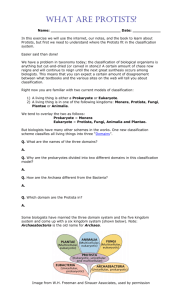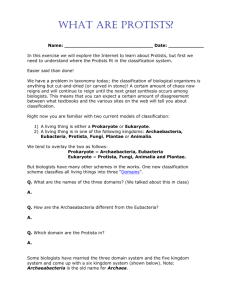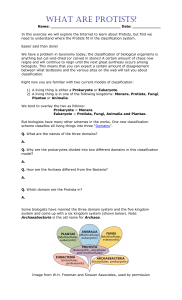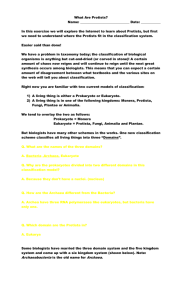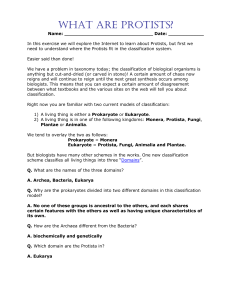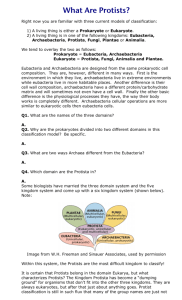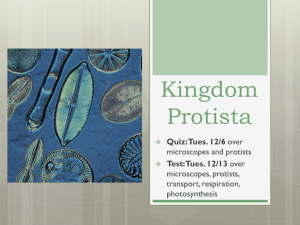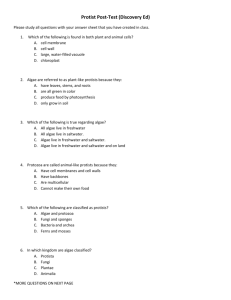Name
advertisement
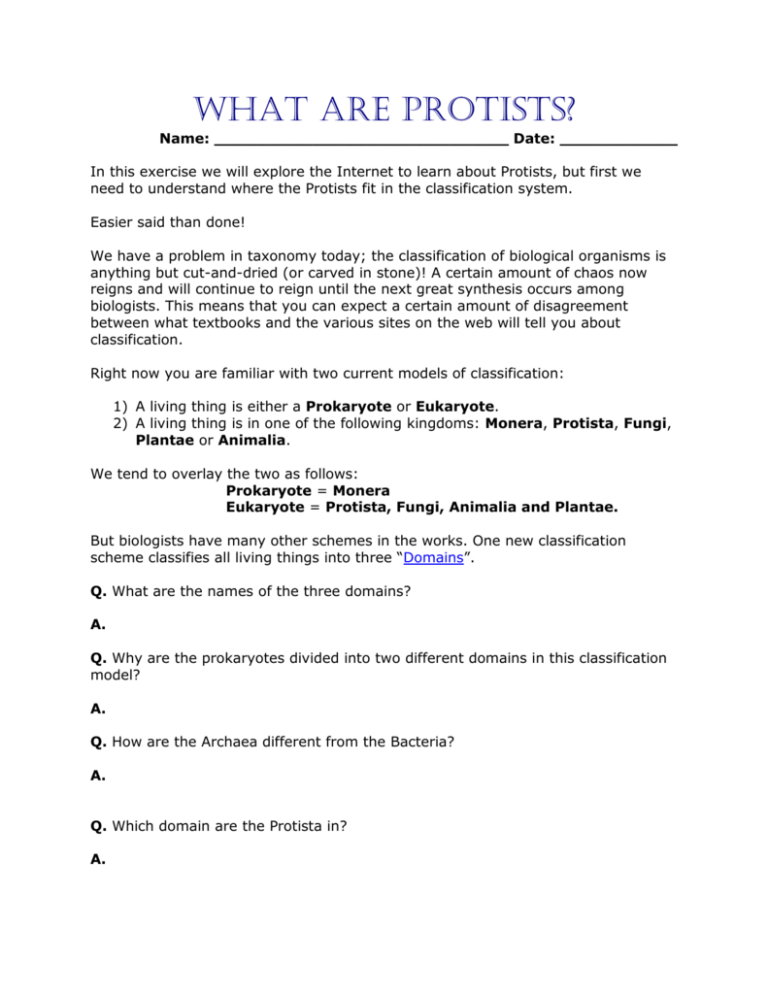
What Are Protists? Name: ______________________________ Date: ____________ In this exercise we will explore the Internet to learn about Protists, but first we need to understand where the Protists fit in the classification system. Easier said than done! We have a problem in taxonomy today; the classification of biological organisms is anything but cut-and-dried (or carved in stone)! A certain amount of chaos now reigns and will continue to reign until the next great synthesis occurs among biologists. This means that you can expect a certain amount of disagreement between what textbooks and the various sites on the web will tell you about classification. Right now you are familiar with two current models of classification: 1) A living thing is either a Prokaryote or Eukaryote. 2) A living thing is in one of the following kingdoms: Monera, Protista, Fungi, Plantae or Animalia. We tend to overlay the two as follows: Prokaryote = Monera Eukaryote = Protista, Fungi, Animalia and Plantae. But biologists have many other schemes in the works. One new classification scheme classifies all living things into three “Domains”. Q. What are the names of the three domains? A. Q. Why are the prokaryotes divided into two different domains in this classification model? A. Q. How are the Archaea different from the Bacteria? A. Q. Which domain are the Protista in? A. Some biologists have married the three domain system and the five kingdom system and come up with a six kingdom system (shown below). Note: Archaeabacteria is the old name for Archaea. Image from W.H. Freeman and Sinauer Associates, used by permission Within this system, the Protists are the most difficult kingdom to classify! It is certain that Protists belong in the domain Eukarya, but what characterizes Protists? The Kingdom Protista has become a “dumping ground” for organisms that don’t fit into the other three kingdoms. They are always eukaryotes, but after that just about anything goes. Protist classification is still in such flux that many of the group names are just not worth learning. In fact, some biologists predict that it is likely the Protista will be divided into 10-12 kingdoms in the coming years! Q. What are the general characteristics of Protista? A. Even though opinions vary widely, the kingdom Protista is understood to consist of three general groups. Use your textbook (pg. 468-485) and the web sites below to create a concept map overview of the Protist kingdom. The following terms should be included in your concept map: http://science.kennesaw.edu/biophys/biodiversity/protista/prot.htm http://biology.clc.uc.edu/courses/bio106/protista.htm Diatoms Golden Algae Ciliates Flagellates Slime Molds Fungus-like Protists Plant-Like Protists – Algae Dinoflagellates Rhizopods Brown Algae Sporozoans Animal-like Protists- Protozoans Red Algae Green Algae Euglenoids Concept Map of Protista Now that you have done the overview, let’s learn a little more about a few interesting Protists. First, a well-known representative of the Plant-like Protists: Euglenoids Euglena have flagella and a gullet like an animal cell. (heterotrophic injestion) Euglena have chloroplasts like a plant cell (autotrophic photosynthesis) And Euglena have been known to lose their chloroplasts, forcing them to absorb nutrients from their envronment (Heterotrophic absorbtion) Consequently, Euglenoids arguably can be classified as animal, plant and fungus! Q. Two reasons the Eugleonoids are considered to be animal-like are: A. Q. What are three ways Euglenoids can eat? A. Q. How do Euglenoids move? Does their flagella indicate the front end or the back end of a euglena? A. Euglena wants to move towards the light for photosynthesis! Q. How does Euglena orient itself so it can move towards the light? Explain in your own words. A. Euglenoids keep their shape because of a pellicle. Q. Define pellicle. A. Now let’s move on to some animal-like protists; the Protozoa Ciliates Ciliates are an example of animal-like Protists. They are covered with up to 17,000 cilia beating from 40 to 60 times a second in a coordinated fashion! Cilia are used for locomotion. A movie of a moving paramecium! The following link is a rather large site on Protista. Scroll down until you find ciliates and answer the following questions: Q. What is the difference between a macro- and a micro- nucleus? A. Q. How do ciliates deal with osmosis and the influx of excess water? A. Q. How do ciliates eat and excrete wastes? A. Q. What are trichocysts? A. Rhizopods Another Protozoan group we shall examine is called Rhizopoda or Sarcodina. A typical rhizopod is the ferocious predator Amoeba proteus. The interesting thing about Amoeba is that their cytoplasm can exist in two states: the liquid “sol” endoplasm and the semisolid “gel” ectoplasm. The two consistencies work together to help the Amoeba move and feed. So how do they move? A quick link explaining how they move. Q. What is a pseudopod? A. Q. How does an Amoeba survive harsh environmental conditions? A. The Amoeba seems like a harmless little guy, but some species are downright nasty! Q. What are the symptoms of amoebic dysentery? A. Just for fun, check out the Amoeba Dance site. Sporozoans Finally, let’s take a look at a not-so-nice group of Protozoans – the Sporozoans. These parasitic organisms cannot move on their own because they do not need to! They are passed from host to host in a constant disease cycle. Q. Scroll down to the section on Sporozoans. Name two human diseases caused by Sporozoans: A. Q. A Sporozoan has a different life cycle from the disease-causing Amoeba you saw earlier. What is the major difference in life cycles?
